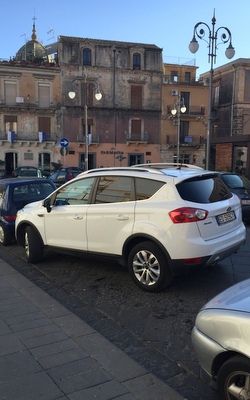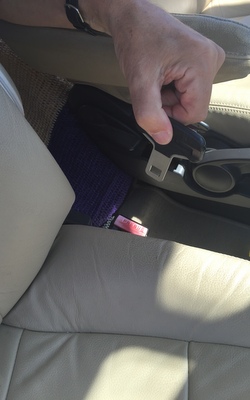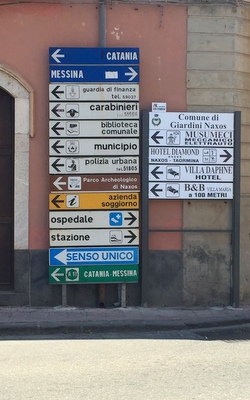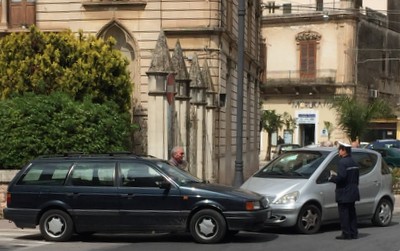Adventures of Parking Australia’s President, Cristina Lynn
I have just spent two months in Sicily with my husband, and whilst the principal objective of the trip was to enjoy good food and wine in the company of new and old friends and relations, we could not help but notice the unique parking, driving and traffic culture on this Mediterranean island. By nature, it is a land of contradictions with some of the most wonderful things surviving along (and despite of) many terrible others…. But I digress!
What I have learned here:
- Drivers feel no embarrassment, nor are they treated like criminals for parking across intersections, at roundabouts and over pedestrian crossings, although they may be fined after the three statuary whistle blows;
- Reverse parking is for losers, the preferred mode being to park nose-in with the rear of the vehicle sticking out onto the driving lane;
- Linemarking showing parking bay placement is merely indicative;
- It is foolish even to consider taking public transport into a city centre. Buses are, at best, irregular and undependable and trains almost non-existent;
- Double parking anywhere is fine, as long as you light up the hazard blinkers;
- Only children, members of cycling clubs on Sundays and a few solitary foreigners attempting the Giro d’Italia, ride bicycles;
- Traffic clogs the towns every day, four times a day, due to the lunch break (and siesta) between 1.30pm and 4.30pm. Heavier jams can occur on Sundays especially if a Saint or Madonna is being paraded through the streets preceded by a marching band. Notwithstanding the inconvenience, everyone sits patiently in their car; we never saw an instance of road rage during our entire stay;
- Despite the usual myth, cars will always stop at a pedestrian crossing (unless the driver is busy on the phone or talking to a passerby and fails to see you). This is partly because most cars are the size of large pencil sharpeners or small dog kennels and risk coming out second best in a collision with a pedestrian;
- Parking meters are relatively rare. The scratchie system works well; it uses up small change and makes Italians feel they’re about to win the lottery;
- Paid parking is by scratchie, which one buys at the tobacconist shop (probably the most successful shops after bars and restaurants, given the amount of people who still smoke here) – the challenge being to park, find a tobacconist, buy the scratchie and get back to the car before the warden has blown his whistle three times;
- On most roads, one side is for free parking and the other for paid with time limitation, the difference being that the former has white lines painted on the road and the latter, blue. There are also yellow marked areas for disabled parking. Whatever the colour, the paint is normally faded, requiring the driver to get out of the car for a closer inspection;
- The streets are shared space in Sicilian towns. Pedestrians rule the road, and may cross anywhere unscathed with no hint of impatience on the part of the drivers;
- Helmets for Vespa riders are optional as is the wearing of seat-belts in cars. To prevent the annoying signal indicating an unsecured belt, buckles (with no belt attached) are on sale at the tobacconists; coincidentally, when seat belts were first introduced, a white T-shirt with diagonal black stripe became a fashion ‘must’ in Southern Italy;
- Traffic lights are practically non-existent and traffic flows effortlessly around hundreds of roundabouts, which are sometimes no bigger than an upside down cup;
- Signage is haphazard, often hidden behind the branches of an oleander plant, used by graffiti artists or sun-faded to the point of obscurity. In town, placed just beyond the intersection, is the signboard you need, the name of your destination among 10 other identically sized arrows to the Hotel Belvedere, the Centro Storico, the Pharmacist, the Carabinieri and the Duomo;
- Sicilians at the wheel of white vans are the fastest drivers on earth;
- Even though it is illegal, common practice dictates that people can park on either side of the road even against the traffic;
- Traffic wardens are employed to provide a service, not to raise revenues. The normal procedure when one of these elegantly clad officers (mostly women) notices an illegally parked vehicle (I can assure you this is not a difficult task) is as follows:
- the warden blows a whistle to alert the offender to the fact that the infraction has been noted;
- the warden continues to patrol the side-walk, whistling at other offenders;
- the driver appears, promising to remove his vehicle as soon as he has finished his espresso, cornetto, haircut, etc.;
- the warden returns and blows the whistle again at which time the driver usually runs out and drives off;
- the illegal space is now available for the next offender;
- by law, a warden must blow his/her whistle three times before a fine can be issued;
- this system means that wardens are as popular as the next man.
- Driverless cars in Italy? As Donnie Brasco would say, Fuhgedaboudit! The Italians don’t even like cars with automatic transmission.
Having said all this, and in a clear demonstration of the earlier mentioned contradictions, the world’s first pilot test of shared transit within an urban zone was recently completed in Ragusa (for more information you can read my recent Linked In post here.)
When arriving and leaving Linate and Malpensa Airports in Milan our friend drove in and out of the car parks using his e-tag – the read time was really fast and no issues regarding reliability of LPR equipment. Can’t think why we can’t be doing this in Australia!











